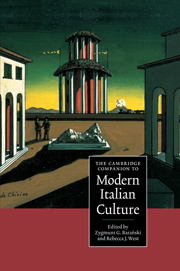Book contents
- Frontmatter
- Introducing modern Italian culture
- 1 The notion of Italy
- 2 Social and political cultures in Italy from 1860 to the present day
- 3 Questions of language
- 4 Intellectuals, culture and power in modern Italy
- 5 Catholicism
- 6 Socialism, Communism and other ‘isms’
- 7 Other voices: contesting the status quo
- 8 Narratives of self and society
- 9 Searching for new languages: modern Italian poetry
- 10 Drama: realism, identity and reality on stage
- 11 Italian cinema
- 12 Art in modern Italy: from the Macchiaioli to the Transavanguardia
- 13 A modern identity for a new nation: design in Italy since 1860
- 14 Fashion: narration and nation
- 15 The media
- 16 Since Verdi: Italian serious music 1860-1995
- 17 Folk music and popular song from the nineteenth century to the 1990s
- 18 Epilogue: Italian culture or multiculture in the new millennium?
- Index
- Series List
5 - Catholicism
Published online by Cambridge University Press: 28 May 2006
- Frontmatter
- Introducing modern Italian culture
- 1 The notion of Italy
- 2 Social and political cultures in Italy from 1860 to the present day
- 3 Questions of language
- 4 Intellectuals, culture and power in modern Italy
- 5 Catholicism
- 6 Socialism, Communism and other ‘isms’
- 7 Other voices: contesting the status quo
- 8 Narratives of self and society
- 9 Searching for new languages: modern Italian poetry
- 10 Drama: realism, identity and reality on stage
- 11 Italian cinema
- 12 Art in modern Italy: from the Macchiaioli to the Transavanguardia
- 13 A modern identity for a new nation: design in Italy since 1860
- 14 Fashion: narration and nation
- 15 The media
- 16 Since Verdi: Italian serious music 1860-1995
- 17 Folk music and popular song from the nineteenth century to the 1990s
- 18 Epilogue: Italian culture or multiculture in the new millennium?
- Index
- Series List
Summary
Introduction
In the last hundred years the Church of Rome has formulated two great projects defining the Christian presence in society: those of Popes Leo XIII (1878-1903) and John XXIII (1958-63). The former was determined by the need to come to terms with the new situation created by the French Revolution; the latter was provoked by the need to adjust to the momentous changes which had taken place since the Second World War. Both projects represented major changes in the orientation of an institution that has always preferred to claim continuity rather than admit change, that 'sees restoration where others see revolution'. The projects focused, in the first case, on establishing the bases for a Christian reconquest of a hostile world; and, in the second case, on changing the Church's approach to an outside world no longer conceived as fundamentally hostile, hence one with which it could enter into dialogue.
The significance of these projects for Italian Catholic culture is obvious in view of the authority of papal pronouncements in the production and propagation of Catholic doctrine. It is well known that the Marxist critic Antonio Gramsci discussed the Catholic Church as an ideological apparatus with its own institutional grassroots structure (parishes and dioceses) and cadres (clergy) whose task was to guide and instruct the faithful about their place in the world. This was traditionally achieved, first, in a largely didactic manner through liturgical activity (sermons, cathechism) to ensure that the simple verities of the faith were continually reaffirmed; and, second, by controlling the orthodoxy of intellectual expression through disciplinary measures such as excommunication.
- Type
- Chapter
- Information
- The Cambridge Companion to Modern Italian Culture , pp. 97 - 112Publisher: Cambridge University PressPrint publication year: 2001
- 3
- Cited by



